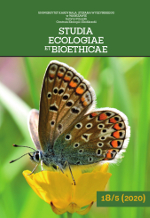The effect of the degree of isolation of alder tussocks on the activity and diversity of epigeic invertebrates
The effect of the degree of isolation of alder tussocks on the activity and diversity of epigeic invertebrates
Author(s): Izabella Olejniczak, Paweł Boniecki, Janusz UchmańskiSubject(s): Agriculture, Energy and Environmental Studies, Environmental Geography
Published by: Wydawnictwo Naukowe Uniwersytetu Kardynała Stefana Wyszyńskiego w Warszawie
Keywords: alder wood;epigeic invertebrates;isolation
Summary/Abstract: Activity and diversity of epigeic invertebrates were studied in 2004 in alder wood (Alnus glutinosa-Carex elata association). The following chosen: fragment of alder wood and 23 alder tussocks with average surface of 0.27 m2. Also, 16 artificial tussocks were installed: 4 of them were the same size as natural ones, and other 12 were smaller, 0.1 m2 in size. The average height of tussock was 0.4 m. Distance between individual tussocks varied from 1 to 2 m. Tussocks were placed 3, 5, 7, 9 and 11 m from the fragment of the alder wood. The material was collected using pitfall traps. Samples were taken every 7 or 14 days twice in the season: when tussocks were or were not isolated by water. The distance from the alder wood did not influence on activity and diversity of epigeic invertebrates on tussocks. Saprophagous: Isopoda and Collembola and predators: Araneae and Carabidae were the most abundant in the samples.
Journal: Studia Ecologiae et Bioethicae
- Issue Year: 18/2020
- Issue No: 5
- Page Range: 317-323
- Page Count: 7
- Language: English

